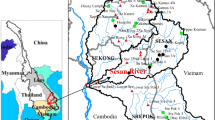Abstract
One of the possible negative environmental effects of hydropower stations is the supersaturation of total dissolved gas (TDG) downstream of high-dams, which can lead to gas bubble disease or even death of fish. By taking the TDG as the main study object, the paper launched the TDG field observations on Zipingpu, Three Gorges, Ertan, Manwan, Dachaoshan, Gongzui and Ertan dams in China. The factors affecting TDG generation and dissipation were explored. Energy dissipation structures, spill rates and operation patterns were the main factors causing TDG supersaturation. TDG saturations are essentially the same in the hydro-electric tail water and in the upper reaches, so hydro-electric tail water can be less TDG supersaturated through mixing downstream. The main factors affecting the dissipation process of the supersaturated TDG were tributary convergence, water depth and turbulence. TDG supersaturation was unevenly distributed in both the vertical and transverse directions. This study is important because it adds to the accumulating experience of TDG field observations of dam projects in China, and because it objectively and impartially evaluates the impacts of supersaturated TDG. The study also provides field data and references for future studies of TDG supersaturation caused by high-dams.
Similar content being viewed by others
References
Orlins J J, Gulliver J S. Dissolved gas supersaturation downstream of a spillway II: Computational model. J Hydraulic Res, 2000, 38: 151–159
Politano M, Carrica P, Turan C, et al. A multidimensional two-phase flow model for the total dissolved gas downstream of spillways. J Hydraulic Resh, 2007, 45: 165–177
Water Resources Protection Bureau of Yangtze River. Investigation of Gas Bubble Disease and Spill of Gezhouba Dam, 1983
Weitkamp D E, Katz M. A review of dissolved gas supersaturation literature. Trans Am Fisheries Soc, 1980, 109: 659–702
Tan D C. Research on the Lethal Effect of the Dissolved Gas Super-saturation Resulted from Three Gorges Project to Fish. Chongqing: Southwest University, 2006
Chen Y B, Peng Q D, Liao W G. The evolvement study on super-saturation of dissolved gas in the middle reaches of Yangtze River after the Three Gorges project running. J Hydroecology, 2009, 2: 1–5
Jiang L, Li J, Li R, et al. A study of dissolved gas supersaturation downstream of Zipingpu dam (in Chinese). Adv Water Sci, 2008, 19: 367–371
US Army Corps of Engineers. Technical Analysis of TDG Processes. US Army Corps of Engineers—Northwest Division, Environmental Resources and Fish Planning Offices, 2005
Li R, Li J, Li K F, et al. Prediction for supersaturated total dissolved gas in high-dam hydropower projects. Sci China Ser E-Tech Sci, 2009, 52: 3661–3667
Author information
Authors and Affiliations
Corresponding author
Rights and permissions
About this article
Cite this article
Qu, L., Li, R., Li, J. et al. Field observation of total dissolved gas supersaturation of high-dams. Sci. China Technol. Sci. 54, 156–162 (2011). https://doi.org/10.1007/s11431-010-4217-8
Received:
Accepted:
Published:
Issue Date:
DOI: https://doi.org/10.1007/s11431-010-4217-8




